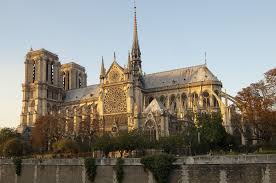18 April 2019
Notre Dame’s Easter.
Death and resurrection.
By Neil Tidmarsh
 Yesterday the Louvre described the fire as “a disaster for the world heritage of humanity”, and so it was; but it could have been so much worse.
Yesterday the Louvre described the fire as “a disaster for the world heritage of humanity”, and so it was; but it could have been so much worse.
The wooden roof and spire have gone; much of the art in the nave must have been damaged if not completely destroyed. But the stone structure still stands. The stained glass in the rose windows has avoided irreparable damage. The towers and the bells inside them were saved. Most of the cathedral’s moveable treasures were rescued. The eighteenth-century organ has survived. The building was safely evacuated and there were no casualties among the emergency services. The fire-fighters are to be saluted for their skill and courage.
What happened? Only a few weeks ago, a number of newspapers reported a recent spate of arson attacks on churches throughout France; the church of Saint-Sulpice in Paris was set on fire last month and 875 French churches were vandalised last year. Accusing fingers have been pointed at “Militant Secularism” for such attacks. But it seems that more mundane and predictable factors were behind the Notre Dame disaster. The great gothic cathedral has indeed been a victim of “militant secularism” in the past (it was re-dedicated to the “Cult of Reason” in the revolution of 1793), but this week it appears to have fallen victim to the kind of ironic tragedy with which we are all too familiar in this country – felled by the dangerously double-edged sword of repair and restoration. Cutty Sark, Charles Rennie Mackintosh’s Glasgow School of Art and Uppark House were all devastated by fire during restoration work. Blow torches, gas cylinders, ancient timbers, the dried-out detritus of centuries – the potential for accidents is clearly huge.
What now? There are three choices: stabilise what’s left and leave the ruin otherwise untouched as a monument in itself (with Coventry Cathedral – post World War II – as some kind of example); build a new cathedral in a contemporary style on what’s left of the old or even to replace what’s left of the old (as in London’s Saint Paul’s Cathedral – the classical / baroque building replacing the medieval building destroyed in the fire of 1666); or rebuild the cathedral exactly as it was (the church of Saint Ethelburga in the City of London was completely rebuilt after it was totally destroyed by an IRA bomb in 1993).
The last option is almost certainly – and correctly – to be chosen. Correctly, because such a beautiful, symbolic, well-known and unique work of art should not be allowed to disappear; the counter-argument about hollow artificiality and fraudulent replication can be dismissed by pointing out that ancient buildings like cathedrals are continually having bits and pieces replaced (arguments about whether a 300 year old axe which has had its handle replaced twice and its blade replaced three times is still 300 years old are always going to be sterile and redundant). These days, most theorists agree that reconstruction is ideologically and aesthetically acceptable if it is fully documented (for the sake of future work) and if the new bits are somehow visually distinct from the old (so that the viewer isn’t fooled into thinking that the new bits are authentic and original).
President Macron has set a five-year deadline for the re-building. Some reports say that it can’t be rebuilt: oak trees aren’t big enough or numerous enough these days; the stone walls are bound to be damaged beyond use or repair by the water and the heat of the fire; many ancient building skills no longer exist; etc, etc. But of course it will be rebuilt; such technical objections can’t be taken seriously thanks to proofs of our species’ ingenuity in reports this week that “researchers have created a living heart from human tissue using a 3D printing technique” (The Times, 16 April) and Chinese scientists have improved the memories of monkeys by “inserting human genes into their brains”. And a staggeringly complete record of the structure of Notre Dame exists and could be used as a blue-print for the reconstruction – thanks to an authority on French gothic architecture, Andrew Tallon, who spent five years scanning the building inside and out with lasers to create a digital image of the cathedral accurate to 5mm. And the money for the restoration looks secure – donations have already reached a billion euros.
Those donations – from businesses and individuals – bode well for the future. All cathedrals and churches in France are owned by the state, and thus their maintenance – and the funds to maintain them – are the state’s responsibility. This is a huge problem. The cash-strapped and strictly secular French government doesn’t have the money, and more significantly it has always been reluctant to spend it on its Christian heritage, for fear of being seen as partisan in its spending priorities (some reports claim that Notre Dame was in such a neglected state that a disaster was inevitable). But at the same time, efforts to raise money elsewhere have been fraught with problems. There’s an ingrained ideological hostility to the corporate sponsorship of cultural issues, and individuals have been reluctant to donate to heritage causes – why should they if the state is responsible? After all, they pay taxes precisely so that the state can fulfil those responsibilities.
This top-down attitude is in contrast to the bottom-up attitude in the UK, where much of our cultural heritage is protected and maintained by individuals donating money as members (and time as volunteers) to charities such as the National Trust, themselves set up by private individuals. The state hardly comes into it (although we should be grateful to John Major for the National Lottery Heritage Fund). The government body Historic England keeps property maintenance at arms length with the charity the English Heritage trust (funded by membership fees, entry fees and donations). From where I’m writing, I can see the spire of the local parish church; it’s clad in scaffolding at the moment while its shingle roof is being restored. The cost is colossal for a small rural parish, and it is to be met not by the state, nor even principally by the Church of England, but by the local community. But somehow the funds have been found, bottom-up, thanks largely to the work of the church’s Friends, a charitable organisation which many of the individuals in the community belong to, not because they’re regular church-goers or even Christians (many aren’t) but because they value the beauty and richness that the building brings to their environment and recognise that it is their responsibility.
But perhaps the public’s deeply generous response to the Notre Dame disaster will see a change in France, and the care and maintenance of its cultural heritage will increasingly be a matter of charitable giving by private individuals rather than tax-funded by government. The change may already have been taking place; last year, a charity modelled on the National Trust was set up in France to protect the country’s castles.
Notre Dame will rise again. This is Easter Week, when the cathedral would have echoed with the two thousand year old story of Christ’s Passion, a story of death and resurrection, destruction and restoration, disaster and triumph; now the cathedral itself has become a powerfully symbolic echo of that story.


